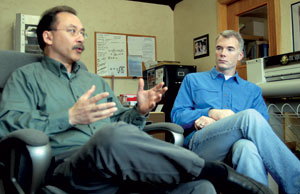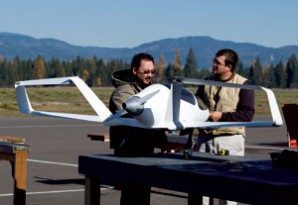John McGinnis thinks it’s time we start making good on our 1960s “Jetsons promise.” That promise was rooted in the belief that we would all be flying around in our own personal planes in the future. McGinnis says the future is now.
McGinnis, a brainy fellow who has spent years designing a more efficient airplane, doesn’t really expect to wake up tomorrow and see the whole world zipping around in space-age aircrafts.
 |
|
John McGinnis, left, describes the development off his Synergy aircraft in his Kalispell office as John Paul Noyes looks on. – Lido Vizzutti/Flathead Beacon |
But he does think it’s time rethink, and reprioritize, our system of transportation. Specifically, he says modern aviation is failing us. McGinnis says there are hundreds of thousands of planes in operation today that were built decades ago and are “aging, obsolete.” And the technology itself, including design, desperately needs to be updated, he said.
“In aviation, nothing’s changed in 40, 50 years,” he said. “Everyone has been handcuffed by the status quo.”
His business partner John Paul Noyes compares the lack of innovation to a 1948 farm truck that has been kept alive only through constant rebuilding and parts replacement.
“It works, but it’s still a 1948 farm truck,” Noyes, a longtime pilot, said.
“People say I’m passionate about aviation,” he added, “but I’m also sort of passionately frustrated with aviation.”
All of which brings us to Synergy, an aircraft design created by McGinnis. In late April, Synergy was unveiled at the CAFE Electric Airplane Symposium in Santa Rosa, Calif. The plane is being widely discussed in aviation circles, including the Experimental Aircraft Association. The magazine Wired featured Synergy in a blog last week.
“Kalispell, Montana, isn’t known as a hotspot of aerospace innovation,” the Wired post states. “John McGinnis hopes to change that.”
McGinnis has already operated an electric radio-controlled, one-quarter scale model of his Synergy airplane for years. Now he’s building a full-scale plane at his Kalispell shop, hoping to finish it in time for July’s NASA-funded CAFE Green Flight Challenge in Santa Rosa. McGinnis believes Synergy has what it takes to win the $1.65 million challenge.
“We have the technology to go against the paradigm,” McGinnis said, adding: “And $1.6 million is a drop in the bucket for what this is worth.”
Even if McGinnis doesn’t have the plane completed and in the air in time for the event, he won’t be concerned because his vision is far more long term than a July competition. He has already spent years developing the technology and even more years researching it, digging through decades’ worth of aeronautical documents. The final product will be ready when it’s ready.
And the proof will be in the final product, McGinnis and Noyes say. They point out that Synergy is not just a blueprint pipedream – an actual 32-foot wingspan plane, using all of McGinnis’ technology, is destined for the air, and the smaller model has already proven itself.
Synergy combines a number of aeronautical principles to create what McGinnis and Noyes believe is the ultimate flying machine with glider-like efficiency. Its shape and other characteristics are meant to dramatically reduce drag, allowing the plane to fly at high speeds with excellent fuel efficiency. Using a DeltaHawk diesel engine, McGinnis said Synergy is capable of running on biofuels.
“It’s double the speed and triple the (fuel) economy,” McGinnis said.
McGinnis has a background in design and three-dimensional modeling. Through his Kalispell business MC Squared Design, he handles the design of a wide range of products, from snowboards to mansions. He is in the business of bringing ideas into reality.
 |
|
John McGinnis, left, works with a radio-controlled scale model of his Synergy aircraft. – Contributed photo by Brendan Rohan, Stumptown Photography |
Noyes, who owns Big Sky Martial Arts in Kalispell, said he flies everywhere he can. He lives on a runway and shoots down to California on vacations, reaching his destination in a matter of hours. He says “people don’t understand aviation,” its practicality and its safety.
His plane gets nearly 30 miles to the gallon, with aviation fuel costing about a dollar more per gallon. But in terms of money saved on hotels and other expenses associated with road travel, he said “it’s cheaper once you own an aircraft.”
“If I need milk, I fly,” he said. “If I need eggs, I fly. Instead of driving 20 minutes, I fly for two minutes. It’s safer and it’s less expensive. There’s no deer up there; there’s no drunks up there.”
He adds: “(Accidents are) always tragic. But they happen all the time in cars. It’s just that aviation gets the headlines because it happens so infrequently.”
Ultimately, Noyes envisions more people using personal aircrafts, spurred by technological advancements such as Synergy. Commercial air travel, with all of its hassles, gives flying a bad name, he said. Synergy, Noyes said, will be comfortable for multiple passengers and able to soar to altitudes above the turbulent weather.
“This is the future of aviation,” Noyes said. “Aviation now is dead. It’s been gimping around for 50 years. This is the future.”